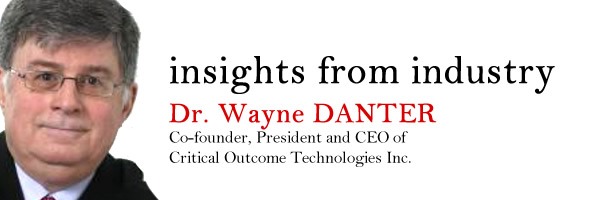
Please can you give an introduction to Critical Outcome Technologies’ lead cancer drug candidate COTI-2?
COTI-2 is a computer-designed small molecule that was discovered by our artificial intelligence drug discovery platform called CHEMSAS.
The molecule has undergone extensive preclinical evaluation at multiple centres in Canada, Europe and the USA. It has been well tolerated in preclinical testing and very effective against human tumours with p53 mutations and/or mutations in the PI3K/AKT pathway.
We have positive results from more than 10 different human tumour xenograft models using COTI-2 alone or in combination with conventional therapy.
COTI-2 is now in late preclinical development being prepared for a Phase 1 study and should be ready for clinical development by the end of this year.
How does this p53 targeted therapy differ from traditional cancer treatments?
Traditional cancer treatments have been largely unfocused in that they indiscriminately kill dividing cells, cancer or otherwise, which often leads to significant toxic side effects in patients.
Targeted therapies on the other hand, try to inhibit one or more abnormal proteins that are found in proliferating cancer cells resulting in programmed cell death.
One or more mutations in the p53 gene are found in at least 50% of all human cancers. These mutations begin a sequence of events that leads to loss of control of cell growth and proliferation.
Due to its central importance in many human cancers, drugs that restore function to mutated p53 proteins have been described as one of the three holy grails of cancer research.
Targeting specific abnormal proteins found only in cancer cells could be expected to be associated with less toxicity in normal healthy cells.
Researchers from the MD Anderson Cancer Center in Texas have recently conducted preclinical experiments on COTI-2. Please can you outline the aims of these experiments?
The aim of these experiments was twofold. First, Dr. Mills at MDACC wanted to confirm that COTI-2 was preferentially killing cancer cells with p53 mutations.
Secondly he wanted to identify the range of different mutations in the p53 gene that were responsive to COTI-2.
What did the research involve and how does it differ from your previous internal research?
Dr. Mills first evaluated the activity of COTI-2 in a number of human cancer cells lines that we had not previously studied. He was able to evaluate the killing activity of COTI-2 in the context of p53 mutations since the p53 mutation status of these cells was known.
He then went on to introduce 32 different types of p53 mutations into mouse embryonic fibroblasts (MEFs), a cell-based system for studying the effect of gene mutations.
Once the p53 gene mutations were established in the MEFs the effect of COTI-2 on those cells was evaluated.
Changes in normal p53 protein levels together with changes in other proteins known to be direct cellular targets of normal p53 protein were also evaluated for each of 32 different types of p53 mutations following treatment with COTI-2.
What were the findings of this research and how did this extend the understanding of COTI-2’s mechanism of action?
Extensive data from the experiments have demonstrated that:
- COTI-2 has a major mechanism of action that is dependent on p53 gene mutation status in human cancer cells.
- COTI-2 restores p53 protein to its normal function in human cancer cells with a wide range of common p53 gene mutations. This range includes three of the most common mutations found in about 20% of all human cancers.
- COTI-2 is also effective in the presence of common mutations in the PI3K/AKT/mTOR cell signaling pathway. This means that COTI-2 is effective in cancers with mutations that lead to over expression of the tumour promoting protein AKT.
- COTI-2 is generally less effective in human cancer cells with no mutant p53 protein; however, it is highly active in some cells where the p53 gene is not mutated such as occurs in some cancers where the p53 gene has been lost.
- The selection of patients for initial clinical trials could be based on the p53 gene mutation status of the patients’ tumour. This would ensure that COTI-2 is administered to patients who are most likely to benefit the most.
What do these findings mean for the future of COTI-2?
These finding support proceeding to clinical trials with COTI-2 in patients with cancers having p53 mutations.
Dr. Mills has established that COTI-2 is potentially effective in a wide range of p53 mutation types.
What would be the impact on cancer patients if COTI-2 does prove to be effective in people with p53 mutant tumours?
Given the central role of p53 mutations in human cancers, COTI-2 could represent a breakthrough therapy for many cancer patients if clinical trials confirm its’ activity in people.
If we consider a specific disease such as ovarian cancer, p53 mutations are found in more than 90% of these tumours. Preclinical animal experiments with a human ovarian cancer known to have a p53 mutation and be resistant to conventional chemotherapy demonstrated that treatment with COTI-2 as a single agent either completely halted tumour growth or lead to dramatic tumour regression depending on the dose. COTI-2 was associated with no observable toxicity in these experiments.
How does COTI-2 compare to other p53 restoration drug candidates in development?
COTI-2 has an effect on mutated p53 protein that is similar to that documented for a few other members of the same class of compounds. COTI-2 is a third generation thiosemicarbazone specifically engineered for low toxicity.
Other drugs in development target the mdm2 protein leading to increased functional p53 by decreasing the destruction of normal p53 protein.
COTI-2 also has a unique effect on the PI3K/AKT pathway via a direct gene level up regulation of a specific protein (PIK3IP) that is known to inhibit PI3K.
This means that COTI-2 is potentially effective in cancers with p53 mutations as well as in mutations of the PI3K/AKT pathway. This effect has been confirmed in an animal model of human ovarian cancer.
What are Critical Outcome Technologies’ plans for the future?
We plan to out license COTI-2 for clinical development so that we can continue the preclinical development of a number of other projects behind COTI-2.
Our company is built around a computational platform for drug discovery and preclinical drug development.
We intend to turn our attention to our acute leukemia program for which we also have patents issued and a growing body of positive preclinical data.
Where can readers find more information?
I would suggest starting with our web site. You can also follow @CriticalOutcome on Twitter and Facebook.
About Dr. Wayne Danter
 Dr. Wayne Danter is a cofounder of Critical Outcome Technologies Inc. and the President and CEO.
Dr. Wayne Danter is a cofounder of Critical Outcome Technologies Inc. and the President and CEO.
He is a pioneer in the evolving interface between artificial intelligence (“AI”) and pharmacotherapeutics.
Dr. Danter is the inventor of CHEMSAS® - a proprietary, AI-based technology platform, which utilizes a series of predictive computer models to identify compounds with a high probability of being successfully developed from disease specific drug discovery and chemical optimization through preclinical testing.
Dr. Danter trained at the University of Western Ontario in Internal Medicine and Clinical Pharmacology.
Prior to founding Critical Outcome Technologies, he was an Associate Professor of Medicine at the University of Western Ontario. His clinical focus at the University was in General Cardiology, Cardiovascular Diseases associated with HIV, and Cardiovascular Risk Management.
CHEMSAS® stems from Dr. Danter’s initial research focused on the medical application of AI technologies to disease diagnosis and outcome prediction. His research has been published in peer-reviewed publications and he has presented at numerous international meetings.